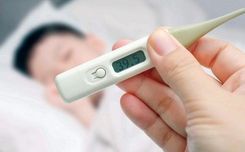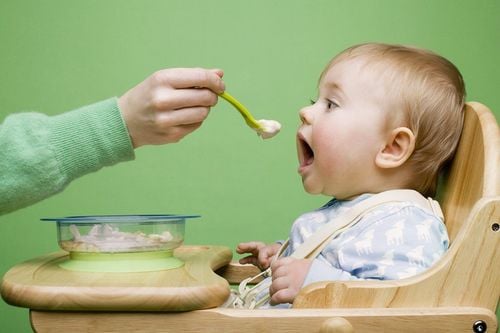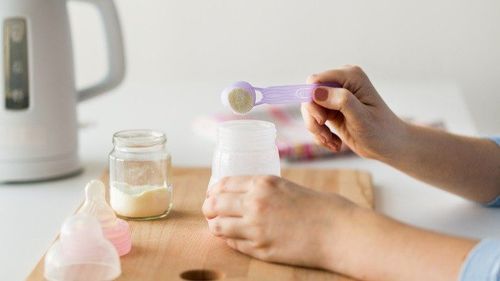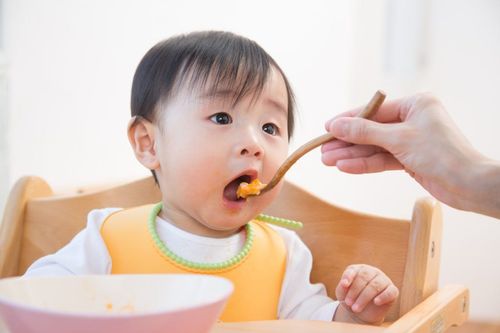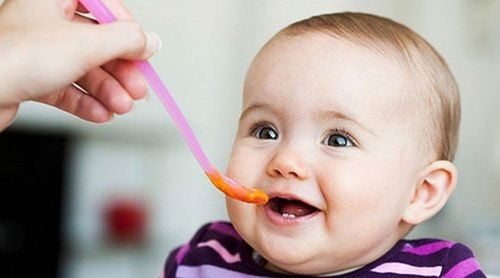How to practice chewing reflex for babies? Most of the parents are very worried when feeding their children solid foods, wondering if their children are suitable for this type of weaning. They fear that the child may choke, cough, choke, vomit when learning raw food and think that the child does not know how to handle food. Therefore, it is extremely important for parents to be equipped with knowledge when feeding babies.
1. Why should children eat solids?
Weaning is an extremely important stage for any child, it will help him supplement essential nutrients and can form eating habits and skills for the baby later. Currently, weaning methods are very popular such as traditional weaning, Japanese weaning, BLW weaning,...
Children should eat solids after 4-6 months depending on the level of weight gain. Before 4 months, your baby's digestive system cannot digest anything other than milk. After 6 months, babies must eat solid foods because:
Milk (breast milk or formula) does not have enough nutrients needed for the development of children at this stage. Develop jaw muscles, tongue... to help your baby easily learn to speak. Help your baby learn to chew to create habits and self-feeding skills later.
2. Children's reflexes when eating solid foods and how to handle them
2.1 The gag reflex is a very useful and safe reflex for children when they eat raw foods that are large, very large, not suitable for children, helping to prevent those foods from entering the road. breathe and avoid choking. In infants from 6 months to under 12 months, the gagging reflex is activated at the tip of the tongue differently than in adults at the base of the tongue, so the child will gag much more easily. Ọe is also a way for children to learn by themselves through eating. After a few gags, your baby will learn to swallow only small, medium pieces of food, not large pieces to avoid choking.
In case the child shows signs of getting stuck in food, choking, coughing and trying to gag to push the food out, this proves that the baby can solve the problem on his own, parents should not be too worried. Calmly, calmly observe the child. Absolutely do not use your hands to pick up the child's throat or give the child water to drink because these actions can cause the foreign body to go deeper into the airway, making it difficult for the foreign body to be removed, and the risk of choking is increased.
2.1 Chewing reflex Chewing is a combination of the tongue and the muscles in the oral cavity to knead and crush food to make it softer and smaller. Teeth are just one of the tools for chewing. Therefore, it is advisable to practice chewing reflexes for babies from about 6-7 months old. This is the period when your baby starts to have a chewing reflex, when most babies have no teeth or only a few, so the best tool to practice chewing at this stage is your baby's gums.
There are many people who think that baby gums are soft and weak, but in fact, this "stick" is extremely effective in handling a variety of rough foods no less than an adult with normal full teeth. Many parents have the habit of feeding their baby powder and porridge until they grow up and have enough new teeth to practice eating and chewing. The baby's chewing reflex in the late stage has been significantly reduced, when the child is older, the gag reflex has been pushed back to the base of the tongue like an adult, making the baby's risk of choking increased, causing danger to the child. Learning to eat raw food at this time will take both time and effort of parents.
When giving raw food to children, parents may experience choking phenomenon. Recognizing danger signs when a child is choking is that the baby will often be silent, unable to cry, cough or cry, and turn pale because at this time the airway is completely covered by a foreign object. If you are with someone else ask that person call an ambulance immediately, while you perform first aid measures for the child. If you are alone with your baby, immediately perform first aid first and then call an ambulance.
Other danger signs: call an ambulance immediately if you notice:
Your baby's throat is swollen (possibly due to a food allergy) Fast heartbeat Sudden fainting
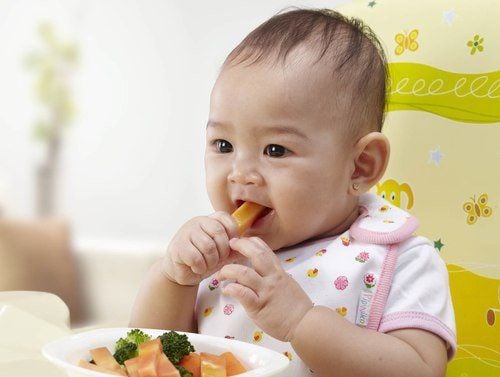
3. How to practice weaning for children
Parents should be patient and calm when practicing weaning. Children should eat slowly, from sweet to salty, from liquid to solid, less to more, from 1 to 4 food groups. You can choose baby foods including:
Commercially available MSG or salt with sufficient nutrition (read nutrition information and usage) Homemade powder with 4 food groups: 1 cup of flour includes 40 grams rice flour. 20 grams of protein (meat, eggs ...) puree (1 ounce is 5 times). 20 grams of pureed greens. 10ml cooking oil (soybean, sesame, olive)
4. The secret to helping your baby learn to chew quickly
4.1 Time for babies to practice chewing Many mothers think that children must have teeth to be able to chew. But not so, even like the self-directed weaning method (Baby Led Weaning - BLW), right from the age of 6 months, parents have trained their baby's chewing reflex by letting the child hold food on his own. eat raw food. Start with soft, well-cooked foods and gradually increase in difficulty so your child learns to eat better.
With traditional weaning methods, children can chew on their own from about 8 to 10 months old, so right from the beginning of solid foods (5.5 - 6 months), parents should let children observe Adults chew by letting them eat with their parents, let them watch their parents practice chewing early and after the weaning period introduce foods for children to chew well.
4.2 Parents chew as an example to help their baby learn to chew Children have a very good ability to imitate, so in order for children to learn how to chew, parents need to show their children how often they chew food. After observing, the baby will gradually form the habit of chewing and practicing them.
However, in order for children to observe the food their parents chew, parents need to clearly divide the foods, to avoid mixing them all together or changing the food structure too quickly. For example, parents often eat green vegetables but constantly switch to cauliflower or carrots, this will cause children not to have time to shape the object that parents are chewing, not knowing what to chew properly, causing confusion. food perception in children.

4.3 Letting your baby handle food by himself The way for a baby to learn to chew is not to feed him, but to let him hold the food and put it in his mouth. When in contact with food, the baby will easily recognize the hardness and softness of the food to adjust the mouth such as opening wider, chewing stronger... Before letting the baby chew on his own, parents can eat first to model, then encourage the child to follow along so that the child remembers the times you chewed like.
The first time for children to practice chewing is an extremely difficult period, because children are just getting used to it, children are too young to know what to do, they can only apply from imitation. Learning to chew for your baby needs to increase the difficulty of the food and change the structure of the food so that the baby learns to chew more dishes.
The above are the notes when starting solids for children, parents can apply to make the baby's weaning process easy and create the baby's cooperation. Refer to the website of Vinmec International General Hospital for more information on how to take care of children in each stage.
Để đặt lịch khám tại viện, Quý khách vui lòng bấm số HOTLINE hoặc đặt lịch trực tiếp TẠI ĐÂY. Tải và đặt lịch khám tự động trên ứng dụng MyVinmec để quản lý, theo dõi lịch và đặt hẹn mọi lúc mọi nơi ngay trên ứng dụng.



